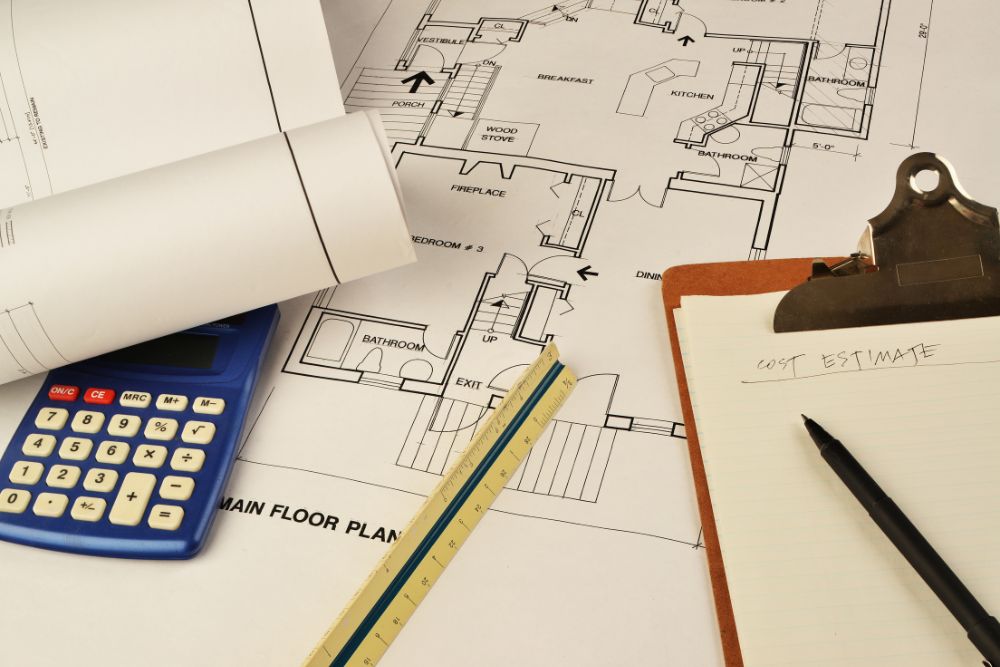In construction, keeping track of time, cost, and progress can be a challenging task. Projects often face delays, budget overruns, or unexpected changes. This is where “what is Earned Value Management in Construction” becomes essential. It is an innovative and structured method that helps project managers measure the performance of a project.
In simple words, Earned Value Management (EVM) compares what was planned with what has actually been done. It helps you see if your project is on schedule, within budget, or needs adjustments. By tracking progress using real numbers instead of guesses, EVM gives a clear picture of a project’s overall health.
In this blog, you’ll learn what Earned Value Management really means, how it works in construction projects, and why it’s one of the best tools for accurate project tracking and control. Continue reading to learn how EVM can enhance the efficiency and predictability of your projects.
What is Earned Value Management (EVM) in Construction?
Earned Value Management (EVM) is a simple yet powerful method used to track a project’s performance. It combines three key elements, scope, schedule, and cost, to show whether a project is truly on track.
In construction, EVM extends beyond simply checking how much money has been spent or how many days have passed. Instead, it looks at how much actual value you’ve gained from the work completed compared to what was planned.
Put simply, EVM works in a few easy steps:
- First, you set a plan, what work will be done, when it will be done, and how much it will cost.
- Then, you track the progress, what has been completed, and how much money has been spent.
- Next, you compare the planned progress with the actual progress and cost.
By doing this, EVM helps you see the real picture. You can easily determine if your project is ahead or behind schedule, under or over budget, and what might happen if things continue at the current pace.
In short, Earned Value Management provides construction managers with clear and objective insights to keep their projects under control and make informed decisions.
Benefits of Earned Value Management (EVM)
Tracking a construction project’s progress is essential for meeting deadlines and staying within budget. However, these are just a few of the many advantages of Earned Value Management. This method makes project tracking more straightforward, more transparent, and more accurate. Here are some key benefits:
- Precise Progress Tracking: EVM displays the amount of work completed and indicates whether the project is on schedule or experiencing delays. It helps you take quick action, like adding workers or adjusting plans, to stay on track.
- Better Planning and Execution: EVM enables teams to plan their daily work more effectively. They can review labor, materials, and progress to ensure they are within budget. It also lets them test different options before spending time or money.
- Early Problem Detection and Risk Control: EVM acts as an early warning system. It helps identify cost or schedule problems before they escalate. This enables managers to address issues promptly and prevent more significant losses.
- Real-Time Performance Tracking: EVM gives live updates on work and spending. You can easily see the progress made and how the project is performing overall.
- Improved Quality Control: EVM gives you reliable data you can trust. It clearly shows where your project stands in terms of cost and time. If something goes wrong, you can use the data to make the correct corrections.
Basic Concepts of Earned Value Management (EVM)
Earned Value Management (EVM) is a crucial method used in construction to monitor project progress. Although it sounds complicated, its goal is simple: to help you see whether your project is on schedule and within budget. Many people find EVM confusing because of its formulas and numbers, but once you understand the basics, it becomes much clearer. Let’s break down the main concepts in easy language.
Planned Value (PV)
Planned Value(PV) indicates the amount of work that a specific point in the project should complete. In other words, it tells you what was supposed to happen according to the plan. PV is calculated using this formula:
Planned % of Work × Budget at Completion (BAC)
Here, the Budget at Completion (BAC) is the total planned budget for the entire project. PV is always displayed as a dollar amount, enabling you to compare planned progress with actual progress.
Actual Cost (AC)
Actual Cost(AC) indicates the actual amount of money spent to date. It includes all expenses, such as materials, labor, and indirect costs. Unlike other values, AC doesn’t have a formula because it’s simply the total amount of money used to complete the work up to a certain point. It helps you understand what the project has actually cost so far.
Earned Value (EV)
Earned Value, or EV, measures how much work has actually been done and how much that work is worth in dollars. It shows the value of progress made. The formula is simple:
Actual % of Work Completed × Budget at Completion (BAC)
EV helps you see how much of the planned budget you have “earned” through completed work.
Schedule Performance Index (SPI)
The Schedule Performance Index indicates how efficiently you are adhering to your schedule. It measures time performance. The formula is:
SPI = EV ÷ PV
SPI is greater than 1; your project is ahead of schedule. If it’s less than 1, you’re behind. If it equals 1, you’re right on schedule. In short, SPI indicates how effectively your time is being utilized.
Cost Performance Index (CPI)
The Cost Performance Index, or CPI, shows how efficiently you are using your budget. It tells you if your spending is under control. The formula is:
CPI = EV ÷ AC
When CPI is greater than 1, you are spending less than planned. If it’s less than 1, you’re spending more. If it equals 1, you’re exactly on budget. CPI helps you track cost efficiency throughout the project.
Schedule Variance (SV)
Schedule Variance (SV) indicates whether your project is ahead or behind schedule, and by how much. It’s calculated like this:
SV = EV − PV
A positive value means you’re ahead of schedule. A negative value means you’re behind. If SV equals zero, your schedule is perfectly on track. SV helps you understand time performance in dollar terms.
Cost Variance (CV)
Cost Variance (CV) indicates whether your project is over or under budget. It’s calculated using this formula:
CV = EV − AC
You’re under budget if the value is positive. If it’s negative, you’re over budget. If it’s zero, your spending matches your plan. CV shows how well you’re managing project costs.
How to Implement Earned Value Analysis (EVA) in Construction Projects
Earned Value Analysis (EVA) helps construction teams measure progress, control costs, and stay on schedule. To make it work effectively, follow these simple and practical steps:
1. Set Up a Clear Project Plan
Begin by creating a detailed project plan that includes the scope, timeline, and budget. This plan acts as your baseline, or starting point, for measuring performance. A solid plan ensures that everyone knows what needs to be done, when it needs to be done, and at what cost.
2. Break the Project into Smaller Parts (WBS)
Next, divide the project into smaller, easy-to-manage sections using a Work Breakdown Structure (WBS). Each section should represent a task or deliverable. This breakdown makes it easier to track progress and manage responsibilities.
3. Assign Budget to Each Task
After building the WBS, assign a cost or budget to each task. This connects every part of the work to a financial value. Doing this helps you track expenses and measure how much value each task adds to the project.
4. Determine the Planned Value (PV)
Then, calculate the Planned Value (PV). It shows how much work should be completed at a specific time according to the schedule. Charting PV gives a clear picture of how funds are distributed throughout the project’s timeline.
5. Track Work Done and Money Spent (EV & AC)
As the project continues, keep track of two prominent figures:
- Earned Value (EV): The value of the work that’s actually completed.
- Actual Cost (AC): The amount of money you’ve actually spent.
Monitoring both helps you determine whether the project is progressing as planned or if there are issues that need to be addressed.
6. Compare Results and Measure Performance
Now, compare the EV, AC, and PV. This step indicates whether your project is on schedule, ahead of schedule, or behind schedule, and whether it’s within or over budget. With this data, you can make informed adjustments before minor issues escalate into major problems.
7. Review and Update Progress Regularly
Finally, review EVA results regularly, ideally on a weekly or monthly basis. Frequent updates enable you to spot changes early and take corrective action promptly. Regular monitoring keeps your project organized, cost-effective, and under control.
 Common Mistakes and Simple Solutions in Earned Value Management
Common Mistakes and Simple Solutions in Earned Value Management
Although Earned Value Management is highly beneficial in construction, many teams still make small yet costly mistakes. These errors can impact accuracy and hinder progress. However, by understanding these mistakes and following some simple solutions, you can manage your projects more effectively.
Mistake | Simple Solution |
Unclear Project Plan: The budget or schedule is unrealistic, resulting in inaccurate outcomes. | Plan properly: Set a clear and realistic scope, schedule, and budget before starting. Break the project down into smaller, more manageable parts. |
Guessing Progress: Saying “we’re almost done” without proof causes errors. | Measure progress: Use real data like completed tasks, materials used, or milestones achieved. |
Late or Wrong Data: Delayed updates make tracking useless. | Update on time: Ensure that you collect and check data regularly. For large projects, review updates on a weekly or monthly basis to ensure progress is being made. |
Ignoring Project Changes: Failing to update the plan after changes can lead to confusion and misalignment. | Manage changes: Use a simple process to track and approve changes. Update your plan when needed. |
Too Complicated System: Utilizing advanced tools for small jobs is a waste of time and resources. | Keep it simple: Use basic tracking for small projects and detailed tracking for large ones. |
Not Connecting Cost, Time, and Work: Tracking these elements separately yields incomplete results. | Combine everything: Link your cost, schedule, and work plan to get a clear and complete project picture. |
Challenges of Using Earned Value Analysis (EVA) in Construction
Earned Value Analysis is a helpful tool for managing construction projects. However, it also comes with a few challenges. To use it effectively, project teams need to understand and manage these issues carefully.
1. Difficult to Set Up and Maintain
EVA can be rigid to set up, especially in the beginning. It requires a clear project plan that outlines all tasks, costs, and timelines. This process takes time and effort. In large projects, tracking numerous details can be overwhelming. Once EVA is in place, it also needs regular updates to stay accurate.
Although it helps control the project more effectively, setting up and maintaining EVA requires a significant amount of work and resources.
2. Keeping Data Accurate and Reliable
EVA works only when the data is correct. Incorrect or outdated data can lead to inaccurate results and poor decisions. For example, it may seem like a project is on track when, in fact, it is actually behind schedule.
To resolve this issue, teams must regularly check and update their data. Conducting data reviews and audits ensures that the information used in EVA is accurate and up-to-date.
3. Need for Training
Not everyone on the team may understand how EVA works. It involves specific terms and calculations that can be confusing. That’s why proper training is essential. It helps everyone know how to use EVA correctly. However, training takes time and money, especially for big teams.
Even so, training is worth it. When team members understand EVA, they can utilize it to make more informed decisions and enhance project performance.
FAQs
What Is Earned Value Management In Construction?
Earned value in construction management is a method for measuring the amount of work completed compared to the planned work. It shows if a project is on schedule and within budget. In simple terms, it helps you visualize the actual progress of the project using cost and time data.
What Is The Formula For Calculating Earned Value?
The formula for earned value (EV) is:
EV = % of work completed × Budget at Completion (BAC)
For example, if a project has a total budget of $100,000 and 40% of the work is done, then EV = 0.4 × 100,000 = $40,000.
What Is An Example Of Earned Value?
Let’s say your construction project’s total budget is $200,000. After two months, 50% of the work is complete.
Then, Earned Value = 50% × $200,000 = $100,000.
This means you have earned $100,000 worth of work based on progress so far.
What Is Another Name For Earned Value?
Another name for earned value is Budgeted Cost of Work Performed (BCWP). It means the same thing, the value of the work actually done according to the budget.
Is EVM Suitable For All Projects?
Earned Value Management (EVM) is most effective for medium to large projects with well-defined schedules and budgets. However, for very small or simple projects, EVM may feel too detailed or complex. Still, using basic EVM ideas can help any project stay on track and avoid cost overruns.
Conclusion
Managing construction projects successfully requires precise control over cost, time, and progress. That’s where Earned Value Management (EVM) proves its value. It helps you compare planned work with actual results, allowing you to easily identify whether your project is on schedule or requires adjustments.
By understanding what is Earned Value Management in Construction, you gain a more innovative way to track performance, reduce risks, and make confident decisions. It turns complex project data into simple, actionable insights.
To keep your projects accurate and efficient, Prime Estimation offers professional construction estimating and CPM scheduling services.
Contact Prime Estimation today to achieve better control, cost savings, and timely project delivery.


 Common Mistakes and Simple Solutions in Earned Value Management
Common Mistakes and Simple Solutions in Earned Value Management









